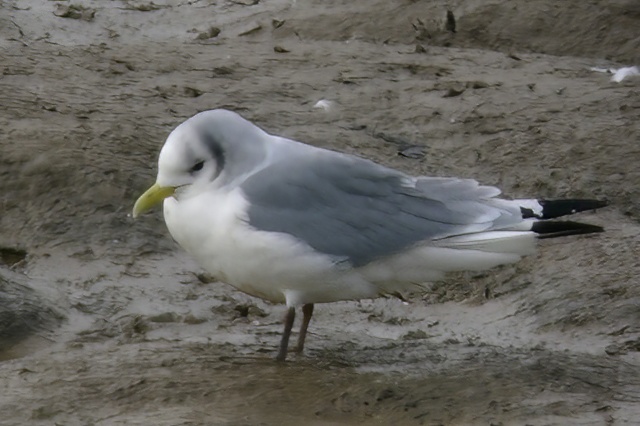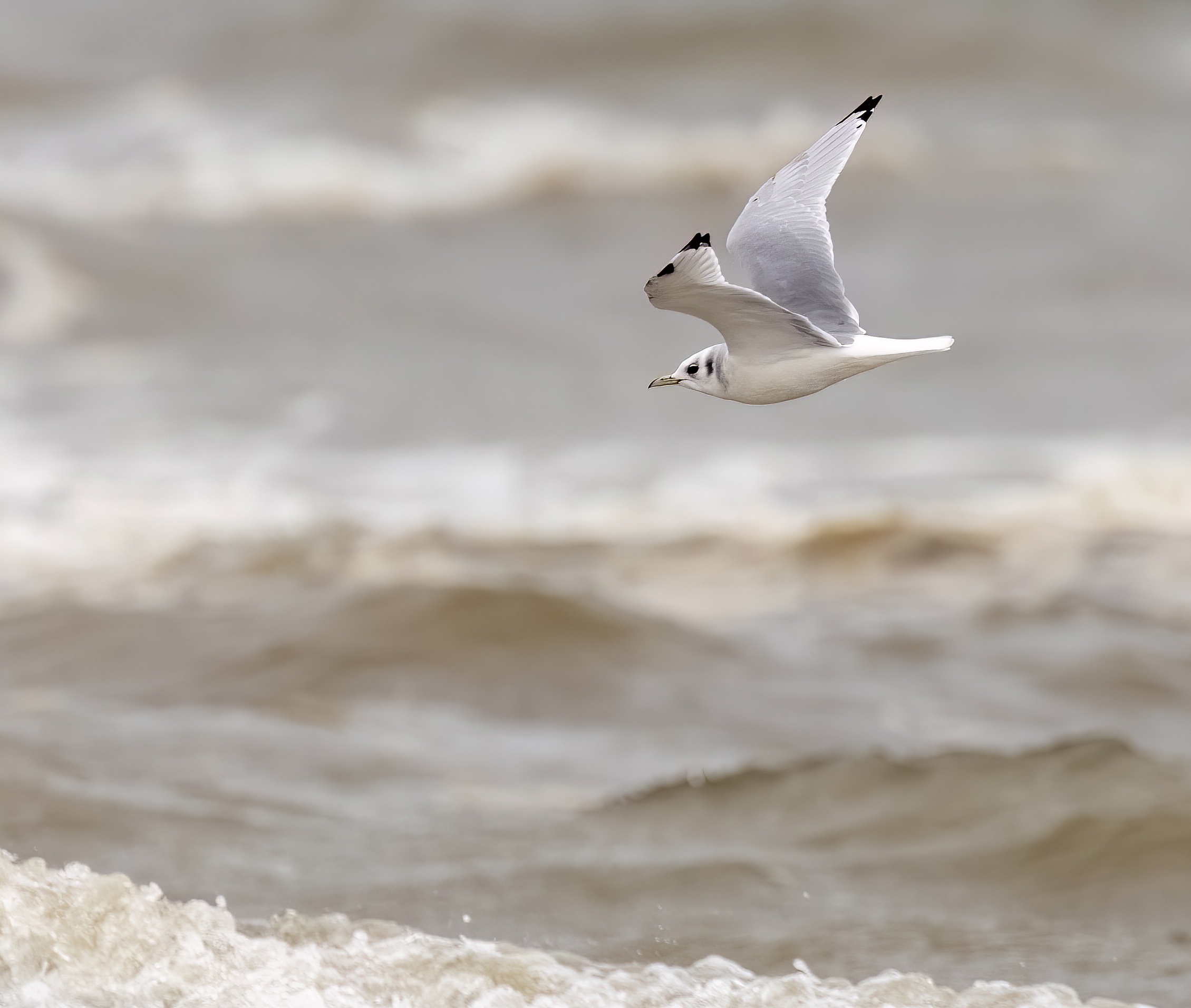Kittiwake Rissa tridactyla
Fairly common but declining passage migrant and winter visitor with small numbers in summer. Scarce inland.


Kittiwakes have been declining for some time. The JNCC report Seabird Population Trends and Causes of Change: 1986-2018 indicates that the UK population fell by 50% between 2000-2018. It’s not surprising then that apart from notable passage days with strong northerly winds, Kittiwakes are getting harder to see in Lincolnshire. The nearest breeding population is Flamborough Point/Bempton Cliffs, about 40 miles north of the Humber Mouth. That population has actually increased by 7% during the period of overall decline. How many of these relatively “local” birds are actually seen off Lincolnshire is open to conjecture. The following information is based on LBR reports for the five years to 2018. Records usually occur in all months of the year with the quietest months being April, July, and August. Of 15,443 birds during 2014-2018, 93% occurred on just 10 days in the 5-year period. The biggest movement was on November 21st 2016 when in a strong northerly 1,800 were recorded heading south off Sutton on Sea and 1,517 off Gibraltar Point. Altogether during those five years, November had 69% of records, October 24% and September 1%. With peaks coming several months after breeding, dispersing birds seen in Lincolnshire could be coming from anywhere in the North Sea and further north.
Ringing recoveries in the county of UK-ringed birds have been of birds ringed as nestlings in northeast England and Scotland. There are also a few historic recoveries of nestlings ringed in Russia and Norway. Kittiwakes ar eprone to being 'wrecked' and such an event occurred in February 1983 when 178 beached Kittiwakes were counted along the Lincolnshire coast (see 'The Auk wreck, February 1983' on the Razorbill web page).
Kittiwakes over Lincolnshire
by G. M. S. Easy
Note: This account is based on the article which first appeared in Lincolnshire Bird Report, 1995.
Kittiwake movements off our shores in the winter months are usually associated with northerly gales. Although it is mainly from mid-October to the end of March that peak movements occur, on occasion large numbers also appear with the skua passage, August to mid-October. Generally, the skua arrivals are associated with tern movements and few Kittiwakes have been noted heading off inland from The South Wash during this autumn period. Inland movements of Kittiwakes have been thought to be gale-driven, but observations at the Nene Mouth during 1995 seem to indicate something rather different: that departure was being instigated by a migratory urge.
As early as January 4th, 1981, I had the first hint of this. Whilst ploughing near Cambridge, with a 1000 or more gulls attracted to the freshly turned soil, I was surprised to note that during a two and a half hour period four flocks of Kittiwakes totalling almost 200 birds passed directly overhead. Each flock was compact, with 26-70 birds in the four flocks, and occasionally spiralled above the conspicuous gathering below but significantly continuing on their southerly heading. Despite being bitterly cold, the wind was only a fresh NW and the birds had obviously arrived here from The Wash.
Following some evidence of Kittiwake gatherings and a few inland departures at Nene Mouth in 1993-94, visits were made there in 1995 on most days with E, N, or NW winds of fresh to gale strength between January-March and November-December to assess Kittiwake departures. Some 45 hr. were thus spent during the year, in which time over 6000 birds made off inland (see table). This is well over half the total number observed and there is reason to suppose that many others present coasting would have flown inland further along the shore. Only on one occasion to date have the bulk of the birds offshore turned northward to deep water for their departure. This was on November 16th when 2500 took this path and only 250 flew inland.
The pre-migratory ritual has much in common with skua departures. Arriving birds mass in a group on the mud at low tide or on the sea until a good number has assembled. Then in a burst of excitement a large group leaves the band, or the whole concourse rises up to spiral about madly. Eventually they either rise to a great height before turning inland or just stream off inland at low or moderate height. Flocks of 250-300 birds moving off have not been uncommon while one group of 500+ rose together and made off on a SW heading on November 3rd. As these disappeared inland, they formed a main flock with two straggling small bands at the rear.
The SW heading of the majority of the Kittiwake flocks, like the skuas, waders and terns, might seem a little surprising. The obvious route ought to be southwards following the course of the River Nene and possibly the Nene Washes, which would be visible once a suitable height had been attained. Approximately 3200 made off SW or WSW in 1995, with another 2700 deciding to follow the river system south. As with skua movements the conclusion must be that the SW heading is a cross-country route to the River Severn. Langtoft and Tallington Pits lie SW of The Wash exit point, but since the birds tend to move off into great palls of cloud this must hamper views of distant landmarks. The impression from the ground is that the heading is pre-determined rather than the result of the birds searching for distant features to steer forwards.
Despite the numbers involved, there seems little chance of picking out these flocks further inland in the county, for while some of the birds on the southerly heading often do not rise to a great height above the Nene, those on the SW route invariably rise steadily higher as they cross Lincolnshire. A further disadvantage is that a group of high-flying gulls is unlikely to merit a second glance, despite the characteristically tight flock formation and unusual heading of these Kittiwakes. As far as I am aware only one report exists of inland movement of Kittiwakes from Nene Mouth prior to the recent observations, that for 1970. It is difficult to see how this volume has been overlooked in the past. Departures have been noted at other south Wash river mouths. At the Welland in the 1950s and 1960s and from Ouse mouth in Norfolk in the 1970s and 1980, but in total less than 2000 birds have been involved in all the pre-1990 south Wash observations. The March 27th figures are difficult to explain. Surely by this time Kittiwakes should be returning to breeding ledges, not moving off south. A high-flying Great Skua seen migrating SW on the same date would appear to have been equally confused.
| Date | Heading WSW/SSW | Heading S | Heading SE | Inland total | Daily total |
| January 11th | - | 1722 | 50 | 1772 | 3072 |
| January 26th | 105 | - | - | 105 | 500 |
| March 27th | 504 | 536 | 75 | 1115 | 1315 |
| November 1st | 225 | - | - | 225 | 225 |
| November 3rd | 1666 | - | - | 1666 | 1666 |
| November 16th | 250 | - | - | 250 | 2750 |
| November 17th | 375 | 425 | - | 800 | 1600 |
| December 5th | 45 | 24 | - | 69 | 100 |
| December 20th | 20 | 40 | - | 60 | 60 |
Winter Kittiwake counts for 1995 showing totals departing inland, with the total daily count (inland + seaward departures) for comparison.
(Account as per new Birds of Lincolnshire (2021), included September 2022)
